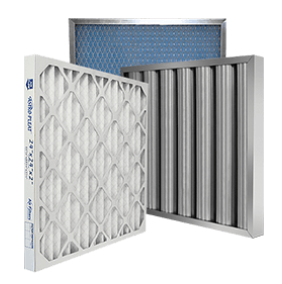We enjoy taking on a tough problem that challenges our ventilation expertise. Recently, a customer came to us with a problem that involved filtering out sand particles from the air. Eldridge was recommended to the customer because of our work on offshore vessels. The customer wanted us to design the best solution for filtering out sand particles from the air. The customer also added the challenge of determining the filter replacement frequency. In this week’s blog, I’ll tell you how we solved this unique challenge of filtering out sand particles.
The Challenge
The problem was brought to us by a shipyard that was converting a vessel into a floating liquefied natural gas facility (FLNG). The FLNG facility would be operating over a large gas field that had been discovered off the west coast of Africa.
The problem with operating an FLNG facility in that location was the frequency of sandstorms coming off the African Continent. The operator of the gas field had collected data on the sizes and volumes of particles from the sandstorms which they provided to us. 
Our challenge was to design a particle removal system that would keep out 95% of the particles at all sizes. We knew that filters would part of the solution. That would require telling the shipyard how frequently the filters would need to be changed. The shipyard needed to know what size area to provide for filter storage and how often the FLNG facility would need to be restocked with filters.
Large Sand Particle Removal Solution
Our experience with the offshore industry had taught us that using disposable filters alone would not be the most economical solution. Filters become loaded quickly with the large particle sizes and must be replaced too often during the sandstorm season. The solution was to provide a first stage permanent filter that would help to prolong the life of the disposable filters. From our experience of providing Sand Filtration Systems for the Power Industry with facilities in the desert, we incorporated the use of sand louvers.
We selected 8” thick sand louvers for this project. They have a 96.1% efficient for removing particles over 1 micron. There were two additional qualities that made sand louvers a great solution for this application. The first is that the louver blade design would also prevent water incursion during heavy rainstorms. The second thing is that sand louvers have fixed blades that are self-cleaning so they require no maintenance.
Small Sand Particle Removal Solution
The next step was to figure out the most economical way to remove the particles below 1 micron. The particle removal goal was 95%. When the goal is that high, our experience is that a two-stage filter is the most economical solution. For the final filter we selected a dispersed oil particulate (DOP) filter which has a 95% efficiency.
For the prefilter selection, we started with the idea of using a highly rated MERV filter because it would capture small particles. Then we did an analysis of the volume of particles the MERV prefilter would capture before block-off. The sandstorm data showed that December to March was the worst period. During this time, the MERV prefilter would need to be changed every 12 days. For the remainder of the year, the frequency of change was every 63 days.
The shipyard was confident in our solution and calculations. However, they had a concern about the frequency of change for the DOP filters. After a breach test was performed of the MERV pre-filter, it was determined the DOP filters could last up to three years with proper maintenance.
Conclusion
Our ventilation design experts had never encountered this exact type of problem. However, we were to design a unique solution with the help of two of our manufacturing partners. No matter the size or difficulty of the ventilation or noise control problem, Eldridge can help you find the best solution. Contact an Eldridge ventilation expert today to find out how we can create a successful environment for your unique application.
